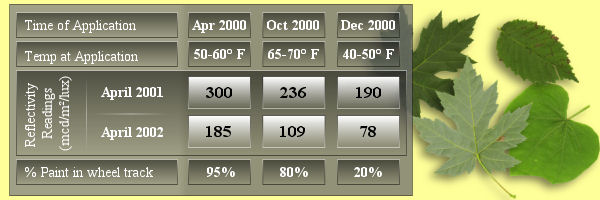 |
 |
Cloudy With A Chance Of CoalescenceBy Mike Speidel
A recent conversation with our friendly paint scientist led to a revelation: spring and summer are better times than the fall to apply markings. Apparently, long-term temperatures have quite an impact on the effectiveness and durability of water-borne paints used on most airfields. "The paint applied in the springtime is usually followed by additional days of warm weather conditions that are optimal for the formation of a tight, well-coalesced paint film," she said. Not understanding "well-coalesced paint film" let alone how to spell it, I urged her on. "What may not be commonly known is the effect of the 'season of application', she continued. Although I thought that might be a holiday, she corrected me. "This refers to the performance provided by a waterborne paint applied in the spring compared to the same paint, applied under the same application conditions, but in the fall season. Although both applications of the TT-P-1952 dry quickly, their performance over time may vary."
This paint has been used for a long time, so I wanted proof; and she gave it to me in this tidy little graphic
below:
"In this example", she explained, "the same high quality water-borne paint and beads were applied to a concrete roadway in April 2000 (at 50o - 60o F) and October 2000 (at 65o - 70o F) - under fairly similar weather conditions. After one and two years, the lines applied in April had significantly better retroreflectivity than the same lines applied in October. The good weather conditions of the spring application resulted in a quicker release of water, solvents, coalescent and additives in the paint, which allowed the paint to cure to a tight bond to both the glass beads and pavement surface, making it more resistant to traffic damage early in its lifetime. The fall application of paint had less optimal 'curing' time and was more susceptible to traffic damage early in its life." "The same type of materials applied under adverse conditions (40o - 50o F) in December showed even lower retroreflectivity performance over time, despite being down on the pavement the shortest length of time. This detrimental effect of low temperature application on long-term performance of standard waterborne paint has been well documented. The need for new technology to solve this type of problem is apparent and the solution is now available. Keep an eye out for our Fall issue to learn more about it.
Spring and summer time application affords the best performance, as you would expect. Getting more life out of
the product is always a plus, so it seems advisable to get started in the spring rather than procrastinating until the fall.
(Information courtesy of Cynthia Randazzo | Group Leader | Paint and Coatings Materials / Traffic Markings Technical Service - Rohm and Haas) |

 Most of us don't trust the local meteorologist further than we can throw them. We'd rather trust a
groundhog or our own aches and pains to let us know what the weather will bring. However, weathermen can generally
distinguish between the seasons and, for the most part, that's all we're concerned with when scheduling painting operations
for the upcoming year. But I have some evidence that may be of value when deciding exactly when to fire up the marking
equipment and lay down some paint.
Most of us don't trust the local meteorologist further than we can throw them. We'd rather trust a
groundhog or our own aches and pains to let us know what the weather will bring. However, weathermen can generally
distinguish between the seasons and, for the most part, that's all we're concerned with when scheduling painting operations
for the upcoming year. But I have some evidence that may be of value when deciding exactly when to fire up the marking
equipment and lay down some paint.
